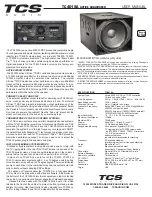
Parameter
Specification
Unit
QA Test
Limits
Conditions
Notes
Turn-on Transient
50
mV-peak
2v-pp
@ Speaker Outputs
AC Line cycled from OFF to ON
Turn-off Transient
50
mV-peak
2v-pp
@ Speaker Outputs
AC Line cycled from ON to OFF
Efficiency
Efficiency
65
%
64
Nominal Line voltage 120 VAC
Stand-by Input Power
24
Watts
26
@ nom. line voltage
Maximum allowable input power under nominal
Input voltage and frequency, HOT or COLD
operation.
Power Cons. @ rated power
234
Watts
240
@ nom. line voltage
150 Watts @ 5.6 Ohms nominal line voltage
Protections
Short Circuit Protection
YES
functional Direct short at output
Amplifier should resume operation after short
circuit condition removal
Thermal Protection
YES
functional
@1/8 max unclipped Power at 1.06
times the input voltage
Temperature rise in accessible metal parts
should not exceed 35K rise for domestic version
or 30K rise for European versions (refer to
requirements sheet).
DC Offset Protection
YES
-
DC present at Speaker Out leads
Design must insure no Offset at the speaker
output under any operating condition including
abnormal operation
Line Fuse Rating
USA-Domestic 2
Amps
2
Type-T or Slo Blo-250 V
Internal fuse with UL/SEMKO rated holder
EU
1.25
Amps
1.25
Type-T or Slo Blo-250 V, Low
Breaking capacity
Internal fuse with UL/SEMKO rated holder
4. ALL SPECS SHOULD BE MEASURED AT NOMINAL LINE VOLTAGE.
SPEAKER CONNECTION
When we designed the
E150P and E250P powered
subwoofers, our goal was
to offer the user the best pos-
sible performance combined
with the most flexible and
complete installation options.
Please look over the following
three examples to determine
which description best
matches your system and
follow the corresponding
hookup instructions.
To use the binding-post
speaker terminals with bare
wire, unscrew the collar until
the hole through the center
post is visible under the collar.
Insert the bare end of the wire
through the hole in the post,
then screw the collar back
down until the connection is
tight. The holes in the center
of the collars are intended for
banana-type connectors.
Speakers and electronics termi-
nals have corresponding positive
(+) and negative (–) terminals. It
is important to connect both
speakers identically:
positive (+) on the speaker
to positive (+) on the amplifier
and negative (–) on the speaker
to negative (–) on the amplifier.
Wiring “out of phase” results in
thin sound, weak bass and a
poor stereo image.
NOTE:
The speaker-level con-
nection method described on
the next page is not a
preferred connection
and should only be
resorted to if your receiver/
processor does not have a
line-level or subwoofer output.
The customer is responsible for
proper connections, and any
damage to JBL or other equip-
ment due to improper connec-
tions will not be covered by
your JBL warranty. Consult with
your JBL dealer or an audio-
installation expert if you have
any questions about how to
connect your subwoofer using
the speaker-level inputs.
3





































